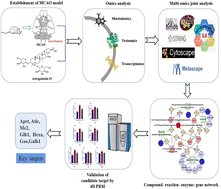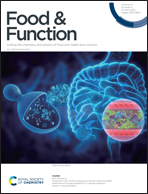Integrated transcriptomics, proteomics and metabolomics to identify biomarkers of astragaloside IV against cerebral ischemic injury in rats†
Abstract
The herb Astragali Radix is a food–medicine herb. A major component of Astragali Radix, astragaloside IV (AS-IV), has neuroprotective effects in IS, but its mechanisms are not well understood. Our research used a transient middle cerebral artery occlusion (MCAO) rat model for longitudinal multi-omics analyses of the side of the brain affected by ischemia. Based on transcriptomic and proteomic analysis, we found that 396 differential expression targets were up-regulated and 114 differential expression targets were down-regulated. A total of 117 differential metabolites were identified based on metabonomics. Finally, we found 8 hub genes corresponding to the compound–reaction–enzyme–gene network using the Metscape plug-in for Cytoscape 3.7.1. We found that the related key metabolites were 3,4-dihydroxy-L-phenylalanine, 2-aminomuconate semialdehyde, (R)-3-hydroxybutanoate, etc., and the affected pathways were tyrosine metabolism, tryptophan metabolism, butanoate metabolism, purine metabolism, etc. We further validated these targets using 4D-PRM proteomics and found that seven targets were significantly different, including Aprt, Atic, Gaa, Galk1, Glb1, Me2, and Hexa. We aimed to uncover the mechanism of AS-IV in the treatment of ischemic brain injury through a comprehensive strategy combining transcriptomics, proteomics, and metabolomics.



 Please wait while we load your content...
Please wait while we load your content...